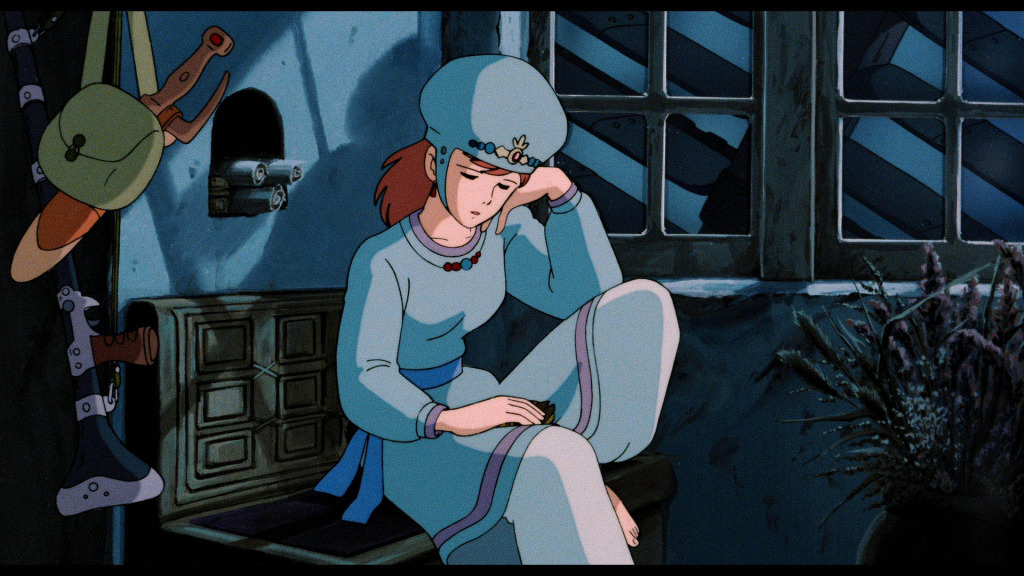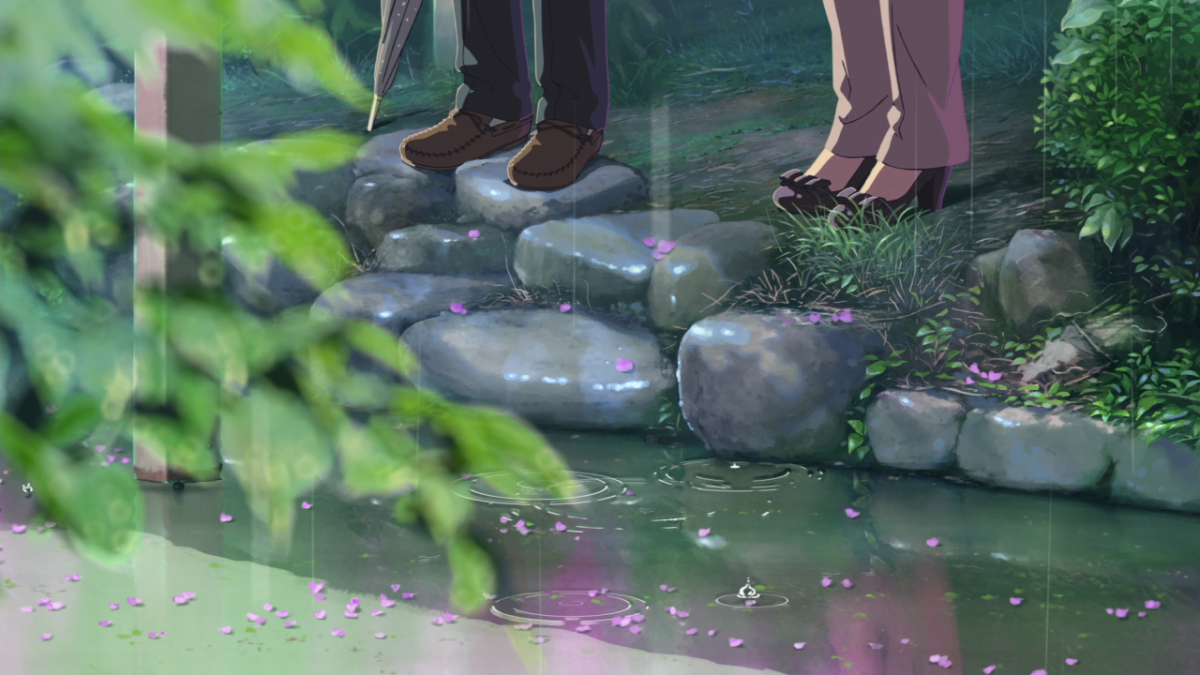It's become far too iconic for you. It would be like Cobpyth or Harry Lime changing theirs.
MoFo MC May: Fantastic Planet (1973)
My thoughts are somewhat scattered from my viewing of Fantastic Planet, the film starts off suave as hell with the electronic score and the opening film title:
Le PlanŔte Sauvage
In this fanastic (or wild plaent, going by direct translation) blue intellectual faints rule over humans. Similar to human interaction with animals, some of the giants consider the humans pests (although acklonledging their high organizational skills), while some of these humans are kept as pets with collars and getting dressed up in ridiculous clothing. While this is just a micro allusion that the film makes, there's a lot of greater symbolism.
The two main themes I reached were oppression (through political systems) and knowledge (which is a tool to fight oppression). It's hard to say which system each life of our protagonist represent. When Terr was kept as a pet to the blue giants, he's like an object of the state. When the domesticated Terr goes into the wild, he joins a more communal system, but which still adores and relies on it's leaders. While it feels that the film is pointing towards the cold war in it's symbolism- space ships representing the scientific exploration for example- it's hard to make a distinction creating a capitalistic and communistic system. Perhaps the film shows they're closer to the same than they're given credit for. Regardless in both systems knowledge brings power, and in both systems it's oppressed.
The animation is very stoic, often leaving lots of blank space, and rarely fluid. There are many great "sanpshots" in the film, often showing creativity, and the images our interesting. But I can't say I'm overly impressed by the animation itself, simply since I've seen more appealing.
The film left me somewhat unaffected, it has some thought provoking spiritual and political under tones, but nothing that lasted.
I think I shall give the podcast a listen now.
Le PlanŔte Sauvage
In this fanastic (or wild plaent, going by direct translation) blue intellectual faints rule over humans. Similar to human interaction with animals, some of the giants consider the humans pests (although acklonledging their high organizational skills), while some of these humans are kept as pets with collars and getting dressed up in ridiculous clothing. While this is just a micro allusion that the film makes, there's a lot of greater symbolism.
The two main themes I reached were oppression (through political systems) and knowledge (which is a tool to fight oppression). It's hard to say which system each life of our protagonist represent. When Terr was kept as a pet to the blue giants, he's like an object of the state. When the domesticated Terr goes into the wild, he joins a more communal system, but which still adores and relies on it's leaders. While it feels that the film is pointing towards the cold war in it's symbolism- space ships representing the scientific exploration for example- it's hard to make a distinction creating a capitalistic and communistic system. Perhaps the film shows they're closer to the same than they're given credit for. Regardless in both systems knowledge brings power, and in both systems it's oppressed.
The animation is very stoic, often leaving lots of blank space, and rarely fluid. There are many great "sanpshots" in the film, often showing creativity, and the images our interesting. But I can't say I'm overly impressed by the animation itself, simply since I've seen more appealing.
The film left me somewhat unaffected, it has some thought provoking spiritual and political under tones, but nothing that lasted.
I think I shall give the podcast a listen now.
__________________
Yeah, there's no body mutilation in it
X
Favorite Movies
X
User Lists
For it's time I don't think the animation left a lot of "blank space". What animation works for you from that time period Donnie?
X
Favorite Movies
X
User Lists
I'm not an animation buff, as most people on the forum know, but there are some styles from the period I like more. Jan Svankmajer's pieces (claymation) from about late 1960s-1980s impresses me much more for example. And in addition animates films that I've seen from today might be a reason why the animation in Fantastic Planet appeared stoic to me.
X
Favorite Movies
X
User Lists
What do you mean it leaves a lot of "blank spaces"?
e.g.




There were scenes with a lot going on in the background, but the scenes with emptiness made the lack of motion more apparent, and while many of these look great as just a snapshot, when it comes to an animated whole it makes the picture seem less fluid, as I mentioned.
X
Favorite Movies
X
User Lists
I think that's a decent observation. Modern animated films are packed with detail, foreground and background, but in the past animation was quite expensive, so it was a lot more minimalist. Lots of scenes only contain the bare minimum. I don't know if this is a problem, exactly, but it's definitely a difference between animation then and animation now.
X
Favorite Movies
X
User Lists
I didn't realize the negative space much because I was paying attention to the finer details of the characters themselves. So that aspect of the film didn't have an impact on me. I see what you mean though.
X
Favorite Movies
X
User Lists
I feel like I am a little late too the party here and everything I have to say has pretty much been covered, but a great podcast guys and some more great posts in the thread.
What Swan says about almost every frame could be framed and admired is definitely true, I definitely disagree with Donnie in that I absolutely love the animation style and think it works fabulously. Definitely felt a Terry Gilliam vibe from it, but it's unique and refreshing in it's own way, it's obviously cheap and allows for a lot of freedom, producing some very memorable and bizarre creatures that kind of reminded me of Flanimals
In terms of plot and such everything's been covered, it's quite a simplistic story that allows for many analogies all involving the dangers of humanity and I do think that as such the lack of real character development and emotional story left me less connected than I could have been to make the film 'truly great'. At the start of the story with the Om escaping from his owner, I thought that might have later become important in a kind of Pocahontas style story, but instead the later half acts less personally and more as a metaphor, all the creatures appear pretty much the same and I didn't really feel any empathy or such towards anyone in particular.
Definitely a very good film, and I'm glad that I watched it. Fascinating to look at and interesting to analysis, but overall I don't think its complex or focused enough for me to become involved to the point where I fell in love.
What Swan says about almost every frame could be framed and admired is definitely true, I definitely disagree with Donnie in that I absolutely love the animation style and think it works fabulously. Definitely felt a Terry Gilliam vibe from it, but it's unique and refreshing in it's own way, it's obviously cheap and allows for a lot of freedom, producing some very memorable and bizarre creatures that kind of reminded me of Flanimals

In terms of plot and such everything's been covered, it's quite a simplistic story that allows for many analogies all involving the dangers of humanity and I do think that as such the lack of real character development and emotional story left me less connected than I could have been to make the film 'truly great'. At the start of the story with the Om escaping from his owner, I thought that might have later become important in a kind of Pocahontas style story, but instead the later half acts less personally and more as a metaphor, all the creatures appear pretty much the same and I didn't really feel any empathy or such towards anyone in particular.
Definitely a very good film, and I'm glad that I watched it. Fascinating to look at and interesting to analysis, but overall I don't think its complex or focused enough for me to become involved to the point where I fell in love.
X
Favorite Movies
I don't care what it's for, but surely I'm not alone in wanting a podcast with wintertriangles and Sexy Celebrity together? That would be gold.
X
Favorite Movies
Lime already got back to me about it, said he preferred not to, so I won't hassle him about it
X
Favorite Movies
X
User Lists
It's in my top 100 animations list (working on it). It's a very intellectual documentary style science fiction movie. I would rate it even higher if I had greater emotional attachment to it though.
Last edited by Guaporense; 06-09-14 at 12:51 AM.
X
Favorite Movies
X
User Lists
I think that's a decent observation. Modern animated films are packed with detail, foreground and background, but in the past animation was quite expensive, so it was a lot more minimalist. Lots of scenes only contain the bare minimum. I don't know if this is a problem, exactly, but it's definitely a difference between animation then and animation now.
Modern animation has about the same level of detail as past animation as backgrounds, which consist the bulk of the detail, have about the same level of detail. Though thanks to computers today it's possible to increase the glossiness of the backgrounds to artificial levels which were not possible using only paint. Character design, though, have become more sophisticated in both 2d and 3d animation.
Compare:
(1984, Nausicaa)



(2013, Garden of Words)




You would be right if you compare a Disney movie from the 1990's like Lion King with a 2012 Pixar movie like Brave:


But I think that Disney films had low degree of visual complexity because the target audience is younger than in most other animated films. Though you should note that American animated features from Disney, Dreamworks and Pixar consist of only a very small fraction of the total number of animated films in existence.
Among the 500 animated films that I have watched I do not notice any overall significant trend in the degree of visual complexity from the mid 1980's onwards. Japanese animated films from the 1980's are about as complex visually as anything made afterwards, although with a less glossly look if compared to the computer processed visuals of Garden of Words (which magnify contrast and everything else to degree impossible with handrawn paintings)
Or if you restrict attention to character design only since with computers you can made a model and move it as you want while in hand drawn animation complexity is restricted since you need to drawn each frame when the character move. Old anime solved the problem while having complex character designs by simply not moving the character at all besides the mouth in most scenes though.

X
Favorite Movies
X
User Lists
Not sure how I missed this before, but here's my reply:
1) You've provided one example (Nausicaa) of an older film with a fair amount of background detail, but you've cherry-picked its shots. Plenty of them are just general hued colors, like this, this and this. That second one wouldn't look out of place behind Ash Ketchum.
2) Your second example is from 2013, and thus inapplicable, given that my statement was more about the intersection of time and cost and not just animation style.
3) I was observing a general trend, not a universal one, so producing a few contrary examples doesn't contradict that.
4) The film that sparked this observation was made in 1973. So when you go on to say "I do not notice any overall significant trend in the degree of visual complexity from the mid 1980's onwards," it's a non-sequitur.
5) I don't think it's remotely accurate to say that modern animation just increases the "glossiness" of backgrounds. Take a look at this:

That isn't just gloss, that's detail. And when you say this was "not possible using only paint," you're agreeing with me. The issue wasn't whether or not we should fault the animators for the lack of detail, but only that there was less detail because various factors--budget, time, the medium itself--limited what they could do.
No.
Modern animation has about the same level of detail as past animation as backgrounds, which consist the bulk of the detail, have about the same level of detail. Though thanks to computers today it's possible to increase the glossiness of the backgrounds to artificial levels which were not possible using only paint. Character design, though, have become more sophisticated in both 2d and 3d animation.
Compare:
Modern animation has about the same level of detail as past animation as backgrounds, which consist the bulk of the detail, have about the same level of detail. Though thanks to computers today it's possible to increase the glossiness of the backgrounds to artificial levels which were not possible using only paint. Character design, though, have become more sophisticated in both 2d and 3d animation.
Compare:
2) Your second example is from 2013, and thus inapplicable, given that my statement was more about the intersection of time and cost and not just animation style.
3) I was observing a general trend, not a universal one, so producing a few contrary examples doesn't contradict that.
4) The film that sparked this observation was made in 1973. So when you go on to say "I do not notice any overall significant trend in the degree of visual complexity from the mid 1980's onwards," it's a non-sequitur.
5) I don't think it's remotely accurate to say that modern animation just increases the "glossiness" of backgrounds. Take a look at this:

That isn't just gloss, that's detail. And when you say this was "not possible using only paint," you're agreeing with me. The issue wasn't whether or not we should fault the animators for the lack of detail, but only that there was less detail because various factors--budget, time, the medium itself--limited what they could do.
X
Favorite Movies
X